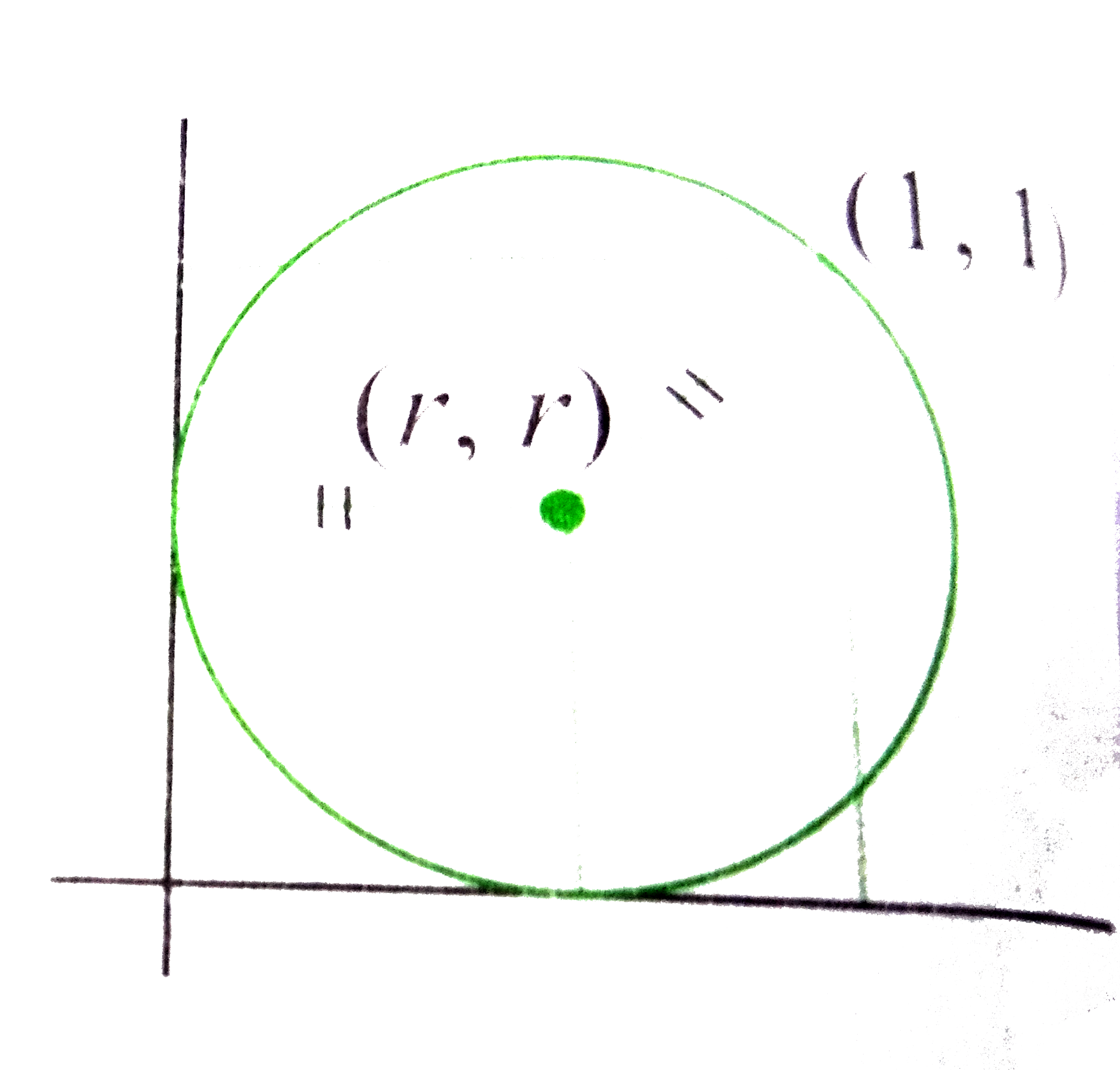ABCD is a square of unit area. A circle is tangent to two sides of ABCD and passes through exactly one of its vertices. The radius of the circle is (a) 2−√2 (b) √2−1 (c) √2−12 (d) 1√2Solution in Bengali
2−√2
√2−1
1/2
1√2
The correct Answer is:1
From the figure,
2(1−r)2=r2
or √2(1−r)=r
or r(√2+1)=√2
or r=√2√2+1=√2(√2−1)=2−√2

Topper's Solved these Questions
- BOOK - CENGAGE PUBLICATIONCHAPTER - CIRCLE EXERCISE - Multiple Correct Anser Type29videos
CIRCLE
- BOOK - CENGAGE PUBLICATIONCHAPTER - CIRCLE EXERCISE - Linked Comprehension Type (For Problem 1-3)3videos
CIRCLE
- BOOK - CENGAGE PUBLICATIONCHAPTER - CIRCLE EXERCISE - CONCEPT APPLICATION EXERCISE 4.172videos
CIRCLE
- BOOK - CENGAGE PUBLICATIONCHAPTER - BINOMIAL THEOREMEXERCISE - Comprehension11videos
BINOMIAL THEOREM
- BOOK - CENGAGE PUBLICATIONCHAPTER - CIRCLESEXERCISE - Comprehension Type8videos
CIRCLES
Similar Questions
about to only mathematics
03:33View SolutionEach side of a square is of length 6 units and the centre of the square Is ( - 1, 2). One of its diagonals is parallel to x+y=0. Find the co-ordinates of the vertices of the square.
02:13View SolutionThree concentric circles of which the biggest is x2+y2=1, have their radii in A.P If the line y=x+1 cuts all the circles in real and distinct points. The interval in which the common difference of the A.P will lie is:
02:28View SolutionConsider a G.P. with first term (1+x)n, |x|<1, common ratio 1+x2 and number of terms (n+1). Let 'S' be sum of all the terms of the G.P., then
The coefficient of xn is 'S' is03:43View Solution
In the diagram as shown, a circle is drawn with centre C(1,1) and radius 1 and a line L. The line L is tangent to the circle at Q. Further L meets the y-axis at R and the x-axis at P in such a way that the angle OPQ equals θ where 0<θ<π2.
Coordinate of Q is03:35View SolutionThe centre of a circle passing through (0,0),(1,0) and touching the Circle x^(2)+y^(2)=9 is a a ((1)/(2),sqrt(2)) b.((1)/(2),(3)/(sqrt(2))) c.((3)/(2),(1)/(sqrt(2))) d.((1)/(2),-(1)/(sqrt(2)))
02:09View SolutionABCD is a square of unit area. A circle is tangent to two sides of ABCD and passes through exactly one of its vertices. The radius of the circle is 2−√2 (b) √2−1 1/2 (d) 1√2
04:43View SolutionLet C be a circle with two diameters intersecting at an angle of 300. A circle S is tangent to both the diameters and to C and has radius unity. The largest radius of C is 1+√6+√2 (b) 1+√6−√2 √6+√2−11 (d) none of these
02:20View SolutionThe line y=x is tangent at (0, 0) to a circle of radius 1. The centre of circle may be:
(a) (1√2,−1√2)
(b) (−12,12)
(c) (12,−12)
(d) (−1√2,1√2)03:16View SolutionLet C be the circle with centre (1,1) and radius 1.If T is the circle centered at (0,k) passing through origin and touching the circle C externally then the radius of T is equal to (a) √3√2 (b) √32 (c) 12 (d) 14
04:02View SolutionA circle is circumscribed around a square as shown in the figure. The area of one of the four shaded portions is equal to 47 . The radius of the circle is (FIGURE) √2 (b) 1√2 (c) 2 (d) 3
05:51View SolutionTangents drawn from (2,0) to the circle x2+y2=1 touch the circle at AandB. Then (A) A≡(12,√32), B -= (-1/2, - sqrt(3)/2)(B)A-= (- 1/2, (-sqrt(3)/2),B≡(12,√32) (C) A≡(12,√32), B-= (1/2, - sqrt(3)/2) (D) A≡(12,−√32),B≡(12,√32)
05:03View SolutionIf a:b=c:d , then prove that (a+c):(b+d)=√a2−c2:√b2−d2
04:59View SolutionABCD is a square of unit area. A circle is tangent to two sides of ABCD and passes through exactly one of its vertices. The radius of the circle is (a) 2−√2 (b) √2−1 (c) √2−12 (d) 1√2
02:53View SolutionLet C be a circle with two diameters intersecting at an angle of 300. A circle S is tangent to both the diameters and to C and has radius unity. The largest radius of C is (a) 1+√6+√2 (b) 1+√6−√2 (c) √6+√2−11 (d) none of these
03:54View SolutionA circle S of radius 'a' is the director circle of another circle S1,S1 is the director circle of circle S2 and so on. If the sum of the radii of all these circle is 2, then the value of 'a' is (a) 2+√2 (b) 2−1√2 (c) 2−√2 (d) 2+1√2
05:47View Solution

